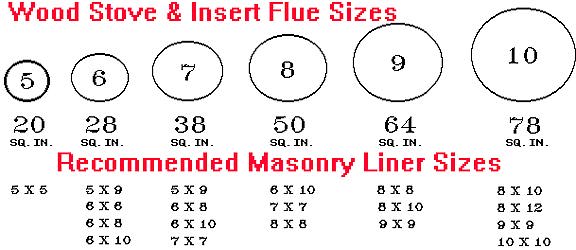 When lining a chimney for a woodstove, wood furnace or wood insert, use the same size stainless steel liner as the exhaust opening on the
appliance. If venting into a chimney with a masonry liner, the cross-sectional area (CSA) of the liner must be at least as large,
but no more than three times as large, as the CSA of the exhaust opening
on the appliance. To ensure proper updraft and minimize creosote formation in the flue, care must be
taken not to vent into a masonry liner that is too large. When lining a chimney for a woodstove, wood furnace or wood insert, use the same size stainless steel liner as the exhaust opening on the
appliance. If venting into a chimney with a masonry liner, the cross-sectional area (CSA) of the liner must be at least as large,
but no more than three times as large, as the CSA of the exhaust opening
on the appliance. To ensure proper updraft and minimize creosote formation in the flue, care must be
taken not to vent into a masonry liner that is too large.
The above chart shows recommended masonry liner sizes below the most common woodstove exhaust collar sizes. The first liner size in each
column is closest to the CSA of the exhaust collar size shown in the circle above it, and is the best choice. Each liner size shown below has a
progressively larger CSA, and is progressively less desirable. In no case may a woodburning appliance be vented into a chimney liner with more
than three times the CSA of the exhaust collar on the appliance. If the chimney is on an outside wall, where at least one face is exposed to the
outdoor cold for the entire length, the sizing rule gets stricter: the liner for an outside wall chimney may be no larger than twice the CSA of the
exhaust collar on the appliance.
======================================================================================
Note: Each Code Authority chooses the standards that regulate appliance and chimney installation and usage in their jurisdiction, and may modify code
specs as desired. The above-referenced specification is from the Washington Association of Building Officials Woodstove Installation Code Book, and
may not reflect the code requirements in your area. Contact your Code Authority for local regulations.
Manufacturers who submit an appliance to a recognized laboratory for safety testing may receive a specific listing for that appliance which may be accepted
by your Code Authority in lieu of the standard code requirements. These listings are unique to each model, and can be found in the appliance's installation
manual.
|


